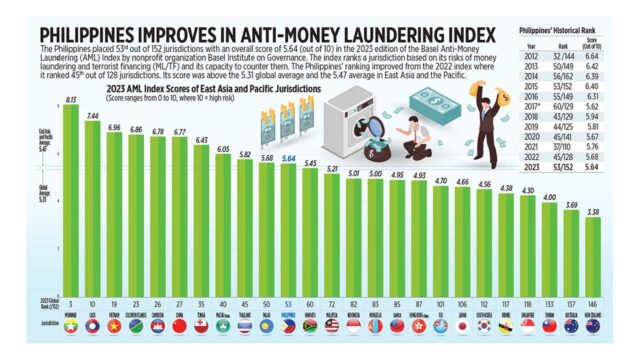Gourmet Giving chefs offer special dinners for charity
INSPIRED by the idea of hapag — sharing a meal with people you love — Txoko Asador Restaurante executive chef Albert Mendoza developed a special menu for “Gourmet Giving Series: A Fine Dining Thanksgiving Experience for the Hapag Movement,” which launches this month as part of a holiday fundraiser for Filipino families who have little or none to share in their own “hapag.” The special menu will include a 10-course tasting menu featuring the best of Basque and Castilian cuisine, with wine pairing to boot. Mendoza’s Txoko Asador is among 12 top restaurants taking part in the Gourmet Giving Series, being held in partnership with the 23,300-strong Fine Dining Club Philippines Facebook community. The Gourmet Giving Series will hold special dinner events from Nov. 20 to 30 in support of the Hapag Movement, a Globe-led initiative that delivers supplemental feeding and sustainable livelihood training for Filipino families experiencing involuntary hunger. Txoco Asador’s special dinner will be held on Nov. 20 at P5,500 per person. Make reservations via 0956-047-3224. Meanwhile, the three restaurants of multi-awarded Filipino-British Chef Josh Boutwood are also participating in the series, starting on Nov. 23 at the Test Kitchen, with a six-course tasting menu available at P5,800 per person (call 0977-288-5751 for reservations), followed on Nov. 24 by Ember, which is offering a six-course tasting menu at P5,800 per head (call 0916-420-1600), and Helm on Nov. 25, with an eight-course tasting menu available for P6,900 (call 0915-909-8647 for reservations). To learn more about the Hapag Movement, visit
https://www.globe.com.ph/about-us/sustainability/globe-of-good.html#gref.
Limited-time holiday dishes offered at SaladStop!
SALADSTOP! unveils two limited-time offerings for the holidays: the White Christmas Salad and the Vegan Chocolate Pudding Loaf. SaladStop! is bringing back the White Christmas salad which is a mix of romaine, kale, chicken ham, walnut snow, sweet grapes, fresh green apples, crispy croutons, and a drizzle of creamy Queso de Bola dressing. Dig into a salad or wrap (P375) or opt for a White Chistmas Party Tray (P1,200 for salad tray, P2,300 for wrap tray) for larger gatherings and holiday feasts. Meanwhile, the Vegan Chocolate Pudding Loaf is available as a full loaf (P600) or a slice (P95). These seasonal offerings are available now until Jan. 2, 2024, at all SaladStop! stores.
BDO partners with Bistro Group for promos
BDO UNIBANK has partnered with food and beverage company Bistro Group to make restaurant dining more affordable for BDO Credit Cardholders. A 50% dining discount awaits BDO Elite, Gold, and Classic Credit Cardholders for a minimum of P2,500 and a maximum of P6,000 food and beverage spend when dining at Italianni’s, TGIFridays, Texas Roadhouse, Watami, Modern Shanghai, Denny’s, Fish & Co., Buffalo Wild Wings, Hard Rock Café, Bulgogi Brothers, and Olive Garden on Fridays to Sundays, until Nov. 26. BDO Elite and Gold Credit Cardholders can also take advantage of a 50% dining discount for a minimum of P3,000 and a maximum of P10,000 food and beverage spend when dining at Las Flores, BCN by Las Flores, Tomatito, Rambla, and Rumba on Fridays to Sundays, until Nov. 26. BDO Elite Credit Cardholders can also avail themselves of a 50% dining discount for a minimum of P5,000 and a maximum of P10,000 food and beverage spend when dining at the restaurants of renowned chef Josh Boutwood — Ember, Savage, and The Test Kitchen — every Friday and Saturday, until Nov. 25. They can also enjoy the same discounts when dining at Helm from Tuesday to Thursday, until Nov. 30. For more information on these restaurant dining deals, visit https://www.deals.bdo.com.ph/deal-welcome/2510.
Christmas at Solaire Resort Entertainment City
VISITORS can now enjoy the merry Christmas vibes all over Solaire Resort with different festive installations found around the property such as the Cadeaux small tree animation from Louis Vuitton, a Santa photo booth at Fresh presented by Coca-Cola, a carousel situated at the Atrium, and several entertainment stages for weekend activities to be held in the Shoppes at Solaire. Enjoy a specially curated menu for Christmas and New Year at the various dining outlets including Finestra, Yakumi, Red Lantern, and Waterside. Finestra is offering a six-course menu for Christmas and New Year’s Eve which includes Slow Cooked Veal, US Striploin, Australian Rib-eye, and more in the options. At Yakumi, guests can savor various set menus which feature Sake-steamed prawn, toro and unagi sushi, US Prime beef strip loin, Duck breast sous vide and other dishes. Red Lantern’s Christmas and New Year’s Eve Dinner Set Menu includes a wide variety of dishes including Wagyu beef tenderloin with egg yolk tart, Sous-vide smoky USDA beef tenderloin, and Wok fried prawn with sweet and spicy sauce. Waterside will be serving up Braised ginger prawn, sushi, Whole roast pork lechon, Crab agnolotti, Grilled Tajima wagyu rump, and more for their Christmas Eve, Christmas Brunch and Dinner, New Year’s Eve, and New Year’s Day menu options. To complete the holiday experience at Solaire Resort, catch the scheduled performances from The Hitmakers, The Bloomfields, the Philippine Folk Orchestra, Jed Madela, Ballet Philippines, Aegis, and more artists for the entire month of December. Solaire is also offering Christmas hampers for gift giving, with a selection of six holiday hampers packed with gourmet treats. Meanwhile, British fragrance and lifestyle brand, Jo Malone London is set to open a physical Jo Malone London store at Solaire’s The Shoppes in December. To celebrate, macarons inspired by the brand’s hero fragrances have been developed. These will be presented in distinctive boxes designed exclusively for Solaire. Try the exclusive Afternoon Tea Menu offer, inspired by the fragrances of Jo Malone London, which includes savories and tea sandwiches, rosemary scones, and various sweets on the menu. Avail of Solaire’s festive room package by booking from Oct. 16 to Dec. 27 on stay dates from Dec. 1 to 29, 2023, with a blackout date of Dec. 24 included. Guests can enjoy a buffet breakfast for two persons at Fresh and in-room welcome amenities with welcome drinks and a P1,000 Solaire bonus peso. Every booking also gets an exclusive Christmas gift from Solaire such as complimentary breakfast for two kids, a complimentary upgrade to Sky Studio, or Happy Hour in Waterside for two persons. The promotion is exclusively accessible through Direct Bookings made via Room Reservations or Solaire’s official website and is valid for all days of the week. For more information and reservations, visit www.solaireresort.com/christmasmagic or call the hotline at 8888-8888.
Frotea expands with 4 new branches in Batangas, Cavite
FROTEA, the milk tea dessert brand, opened two branches in Ibaan and Rosario, Batangas last September, and will be launching two new locations in Bacoor, Cavite, in the first quarter of 2024. Frotea offers affordable milk tea flavors and desserts — like Dark Choco Ice which is Frotea’s take on the Korean dessert bingsu — for less than P100. As Frotea expands, so does its menu. Dark Choco Ice is among their newest desserts alongside fish waffles, another Korean-inspired treat, with a crunchy exterior and a sweet creamy filling; and soft-serve Panda ice cream, a velvety dessert best paired with popping bob. Guests can try a wide variety of flavors from their Classic, Cream Puff, Signature Oreo, and Ube series, or opt for a lighter treat with their Fruit Teas.
Mang Inasal offers free Chicken Inasal Pecho promo
MANG INASAL amps up its year-long 20th anniversary celebration with the #MangInasalAt20 Pecho Panalo Buy 2 Get 1 Promo. The special offer gives away free Pecho Large Solo (one rice) for every purchase of two Pecho Large Value Meals. It can be enjoyed via dine-in, takeout, or delivery on all Tuesdays, Wednesdays, and Thursdays of November at all Mang Inasal stores nationwide. Visit www.manginasal.com for the latest news, https://manginasaldelivery.com.ph for delivery deals, and follow Mang Inasal on social media for updates.
Filipino cookbook in French released
HAILING from a French-Filipino family, author Myrani Miranda-Pesquet has released Une Bouchée des Philippines, a Filipino cookbook written in French. The book contains 50 recipes for breakfast, appetizers, main courses, and desserts/snacks, with each recipe accompanied by a photo. There are also tips, anecdotes and a collection of poems about key ingredients in Philippine cuisine. The recipes were chosen based on the availability of the ingredients in France. Une Bouchée des Philippines is available on Amazon on Kindle/ebook and paperback format, and at the Dédicaces bookstore in Paris, France.
Jollibee stores light up the holiday season
JOLLIBEE opened their nationwide Joyful Christmas Stores on Nov. 9 with simultaneous events in Manila at Jollibee Bonifacio Global City (BGC) Triangle Drive, in Davao at Jollibee Quimpo, and in Cebu at Jollibee General Maxilom through a ceremonial lighting of the stores with a giant socket and plug. This officially commenced the lighting of 10 flagship Jollibee stores across the country, with another 100 stores with their own merry light displays. For Luzon and Visayas stores, the brand partnered with Coca Cola Philippines. Drop by any of these branches to experience the magic of a Jollibee Christmas: BGC Triangle Drive, Madrigal, North Fairview, Baras, Katipunan, and 9th Ave., all in Mega Manila; Binalonan, Pangasinan; Tagaytay Rotonda; General Maxilom DT Cebu; and Davao Quimpo DT.




















